What is a Travelator?
A travelator is a horizontal conveyor system aimed to move users of any age over short to medium distances and back in comfort. Its scrolling plane has only one direction of movement.
Unlike the escalator, the travelator is meant for lateral translations. Everyone gets tired of running too fast. Nowadays, every travelator is of modern safety design to avoid any kind of mishaps. It is bilaterally designed and helps people to comfortably move heavier objects.
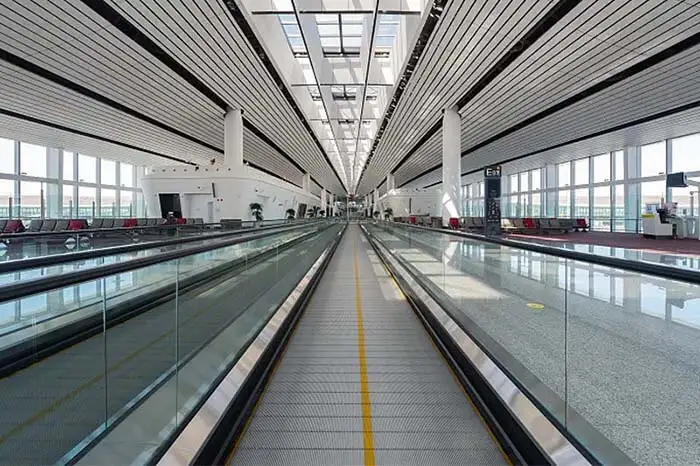
How Does A Travelator Work?
The working principle of the travelator is simple. It is composed of components that work and contribute to the performance of the travelator. Here, the core parts of the travelator are:
Belt or Roller: The Travelator contains a belt or roller that moves in one direction.
Motor: All travelators contain motors that are powered electrically.
Frame and Tracks: These elements provide deflection to the elevator.
Safety Sensors: All elevators are fitted with safety sensors to minimize accident opportunities.
Handrails: The handrails are used for passengers’ support.
The travelator motor drives the rollers so that they move continuously. The motor power can be modified via a control panel. The roller’s surface is slip-resistant so that the passenger does not get into any accidents or slips.
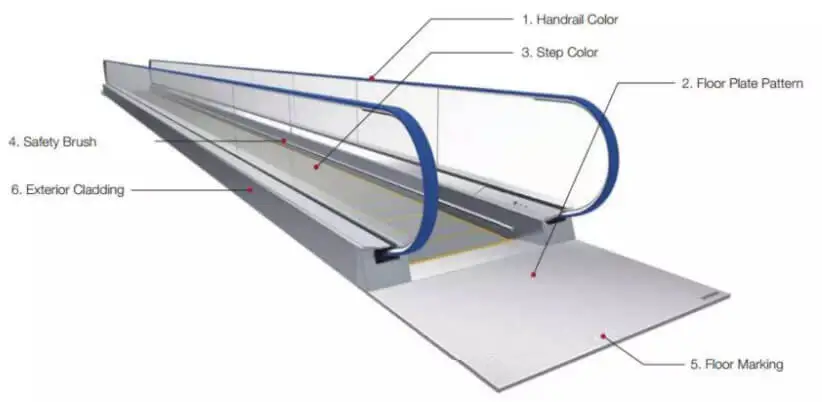
Types of Travelator
There are two kinds of travelators available on the market. These varieties are different in design. However, they’re both meant for carrying humans to places that don’t require a long walk.
Pallet Type Travelator
This kind of travelator has a deep platform which is large enough to carry passengers. The surface of the platen travelator is composed of strong segments which are moved in tracks by a belt. Normally the segments are made of metal or composite.
The working mechanism of this system is simple. The motor provides power to run the roller on a continuous track. The passenger can step on and off without losing balance.
Features
- You can use it in heavy traffic areas due to study construction.
- The simple design helps you maintain it easily.
- Durable and built to last.
- It has a sizable weight-carrying capacity as a compass-to-belt type travelator.
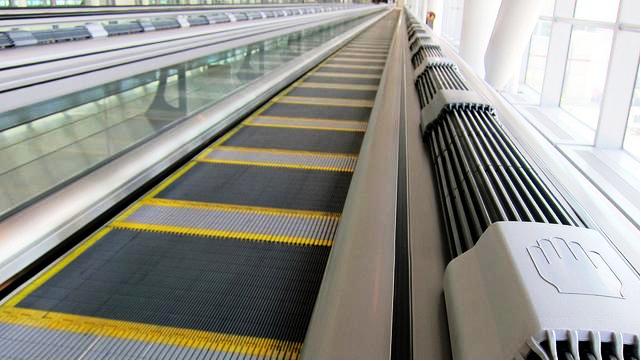
Belt Type Travelator
On the other hand, belt-type travelators use continuous belts to move the passengers. The belt is made of rubber, which provides smoothness and flexibility to the surface.
This travelator is designed to be simpler and less noisy than a pallet-type travelator. It is commonly seen in exhibition halls.
The working rules of this travelator are slightly different from the pallet type. The motor drives the roller to move in a continuous loop. Passengers can walk and stand on the belt.
Features
- Easily to install and maintain.
- Less noisy mode of operation.
- Smooth surface ideal for indoor places.
- Less expensive and cost-effective.
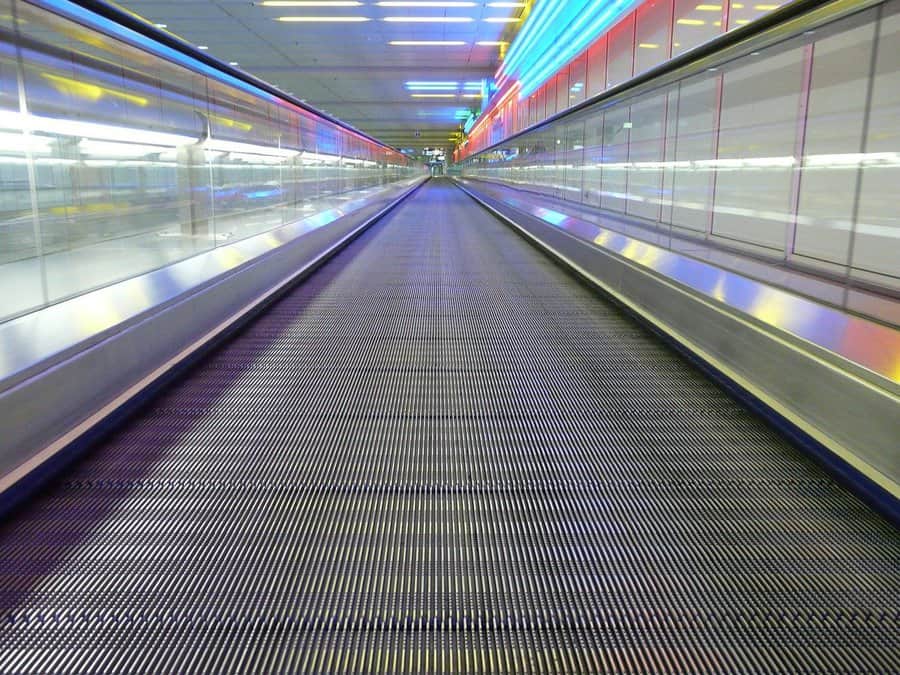
How Much Does a Travelator Cost?
The cost of installing a travelator depends on multiple factors. Generally, the average cost is between $20,000 and $100,000.
However, the cost fluctuates based on the project’s specific requirements, the supplier, and the type of travelator you want to buy. Other factors influence the price range.
Below are the factors that influence the overall expense.
1. Travelator length
This is one of the most important factors that influence the cost of travel. The travelator with a more extended in-length design needs an additional motor and roller that increase the price range.
For example, a 10-meter moving walkway costs between $15,000 and $25,000.
Moving walkways 30 meters and longer cost between $30,000 and $100,000.
2. Step width
The step width significantly impacts the price of the elevator. If you choose an elevator with wider steps for passenger comfort, the cost of this system will increase. This is because more material is used in wider than normal steps.
3. Schedule of Inclination
The angle of inclination of more than the average due and more incorporating stepper engineering components elevates cost. Maintaining the function, offering an inclined angle is no trouble to ensure passengers security.
4. Ornamental Materials
The price of the travelator depends on the decorative material you are using in the travelator. The more expensive decorative materials, such as stainless steel or glass, you use, the higher the price of the elevator.
5. Indoor Space vs. Outdoor Space
Mostly, travelators are designed with the intention to tend to be used indoors. These systems now come with enhanced features such as strong frames, water resistance, and rust-resistant materials that can be used outdoors. However, such added features will multiply the total cost of installing the travelator.
If you need a quote for a travelator project or want to learn more about staircases, feel free to contact Dazen. Our sales experts are here to provide you with the best advice.
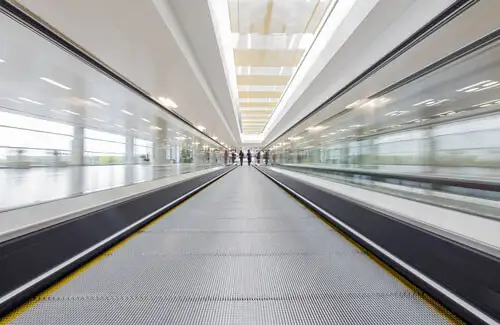
What is the Application of the Travelator?
By and large, it is possible that the travelators are most often used in public or commercial places for the purpose of the movement system. Here are several great examples of places where travelators are found.
Airport: The airport, an international travel hub, has also integrated moving walkways to provide its passengers quicker access between the boarding gates, terminals, and the baggage handling.
Convention Centers: Traveling lifts are used in convention centers as connections between meeting, conference and exhibition areas so people do not have to waste time and effort in crossing long distances.
Shopping Malls: Most of the large shopping centers and malls are multi-level and have large plazas. Connectors and travelators are positioned in specific areas of the mall that connect different parts of the business. Passengers transfer between different levels and prevent congestion.
Resorts and Theme Parks: These are high priced sections. As travelators are fitted in these sections, it makes it easy for the travelers to look around the different sections with maximum comfort.
Train and Metro Stations: People roam the town with trains and metro at peak hours so it is not a rare occasion to see stations packed with people. As such, travelators are fitted to help passengers move through congested stations.

What is The Difference Between an Escalator and a Travelator?
There are times when travelators and escalators are interchangeably used, bearing in mind their purpose: moving people in congested areas. Still, these two are distinct as they have many differences:
Movement
The core difference between a travelator and an escalator is the movement. A travelator is fixed on a surface which is flat or has a very mild slope. Escalators on the contrary rotate around a vertical or very steep axis. For that the seamless bands are used to carry passengers moving vertically from one floor to another.
Inclination
Another important feature which also helps to differentiate travelators and escalators is the inclination. A travelator has a slope which is 12 degrees and escalator is with angle slopes of 30-35 degrees.
Uses
Both serve different purposes. Travelers are mostly used in the airport, shopping areas, and resorts. While the escalators are mostly designed for train stations, hotels and convention halls.

Frequently Asked Questions
How Fast Can Travelator Go?
The travelator speed is determined with the structure properties and application area. The average speed of the traveler is between 0.5 and 1.0 meters per second to ensure the comfort of the passengers over long distance movements.
How Many Inches of Travelator Average is Its Width Measurement?
The average measurement for a travelator can differ due to the location and design for its intended use. From the existing design there are three basic standard widths which use 24 Inches 61cm, 32 Inches 82cm & 40 Inches 102 cm. It uses a height between 10 to 15 degrees.
Is It Possible to Incline the Moving Walkway?
Yes, it is used to incline the moving walkway, the incline has a small beneficial angle. For inclined travelators, however, 0° to 12° seems the limit for the range of inclined angles. The slope helps people to move between different levels, for example, two floors of a mall and an airport while easy walking is considered.
Wrap Up
In conclusion, travelators are found in differing public and commercial facilities that are frequented by numerous people who want to facilitate movements. They are most effective when horizontal distances have to be traveled, including airports and railway stations.
Facility installations for the travelator also should take consideration of length, width and the desired environment. If you are looking for a reliable, high-quality, and cost-effective traveler, Dazen Elevator provides an excellent elevator that meets your various needs. The traveler system is made to ensure safety, ease of maintenance, and efficiency. Their customer support makes them a top choice for any public or commercial space.
